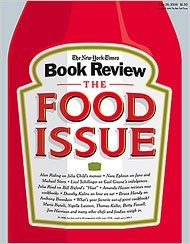
I’ve been really surprised by the vitriol spewed in the blogosphere about last week’s New York Times Book review. The section, with a big graphic of a ketchup bottle on the cover, was devoted to books on food.
A number of sites were incredulous at the selection, pointing out with disdain that this was the second themed Book Review in two weeks. The other one was a review focused on literature.
One blogger even went so far as to call the special section a “repulsive pretender,” and say he did not see one book reviewed that he wanted to read.
Now I understand the general griping about the NYTBR and its editor Sam Tanenhaus. It goes something like this: the section doesn’t review enough fiction and barely even considers fiction in translation or novels from emerging authors. Its reviewers are almost all male and white, with a few white female reviewers thrown in occasionally to appease the masses.
Fellow blogger Ed Champion has almost made a second career out of critiquing the New York Times Book Review. For months, he has graded the section and if he found it well-balanced in terms of fiction and non-fiction, male and female authors, male and female reviewers, he would award Sam Tanenhaus a brownie. If he found the section wanting he would DENY the brownie!!!
Now, while this is funny, I have never figured out if it is a literal or figurative brownie. (Ed, did you ever really send anything?) But the brownie metaphor came up again at a panel at the recent BEA conference. The NYTBR took it upon itself recently to select the best American novel of the last 25 years. They queried a number of authors and selected Toni Morrison’s Beloved as THE BOOK. The runners-up were mostly male (Phillip Roth and Don DeLillo’s books got a lot of votes). Naturally, almost no one except the editors of the NYTBR thought the nominated books reflected the canon of American literature, so the panel discussion at BEA was lively. Ed tried to make some points:
“I stood up and pointed out to Tanenhaus that the list of judges was mostly male and that this reflected a continuing trend by the NYTBR as a whole to give the majority of its reviews to men over women. I also asked how a weekly book review section that continued to prioritize nonfiction over fiction could legitimately put out a “Best Contemporary Fiction” list. I then revealed myself to be the Tanenhaus Brownie Watch guy and playfully asked why I hadn’t received a single thank you note for the brownies. “Is this a New York thing?” I asked.”
Why do so many bloggers care about the New York Times Book Review? After all, isn’t their reason for being to provide alternative voices to the mainstream? Isn’t that why they created the LitBlog Coop? To share fiction that hasn’t received wide-spread recognition?
I think the anger at the New York Times Book Review stems from this: most people rebel against authority at some stage in their lives and to lit bloggers, the NYTBR represents the mainstream publishing industry. It’s a difficult industry to break into, a very insular and often myopic group, and bloggers are pissed off they are not regarded with as much respect as they think they deserve. (Why else would they crow every time they are praised by a newspaper or other vehicle of the mainstream media? For example, Mark Sarvas has as a tagline at the top of his blog with these comments: A Forbes Best of the Web Pick; A Los Angeles Magazine Top Los Angeles Blog) Bloggers keep telling publishers that lit blogs are the way to create buzz for books, but the technology-phobic publishing industry hasn’t really caught on yet.
I think this rebellion may prove ultimately to be a good thing. I just think it will take years before the NYTBR redefines what it considers important literature. Every year the critics anoint some new writer, and increasingly they are people who write about our multicultural world. (Zadie Smith, for example) But the NYTBR will always reflect a New-York centric viewpoint and we all know New Yorkers consider their city to be the center of everything important. (Sort of like how the U.S. thinks it’s the greatest – and only important – country in the world)
But back to the food section. I want to disagree with all the negative ranting. I really enjoyed this section. Having just finished Michael Pollan’s book on the food industry – a book I consider really important – I loved finding out about books that explored American passion for food. After reading the review of Bill Buford’s Heat, a memoir that talks about his internship with chef Mario Batali, I immediately reserved it at the library. The review also made me want to read Julia Child’s memoir on food and France. I had heard a lot about the book but before I read the review I was lukewarm.
And isn’t this what a book review section is for? To make us go out and read new books? Honestly, how many books can an average person read a year? 20? The NYTBR reviews that many books each week. So even if the section give short shrift to contemporary fiction and emerging authors, it does provide great suggestions for books on a regular basis. And that is its job.






